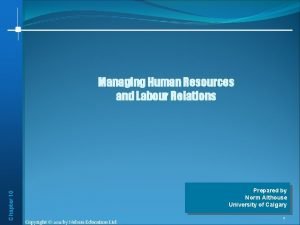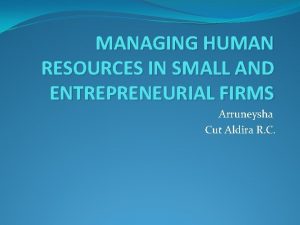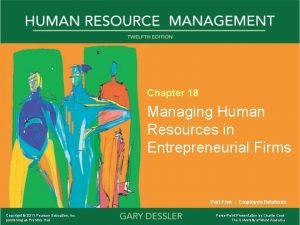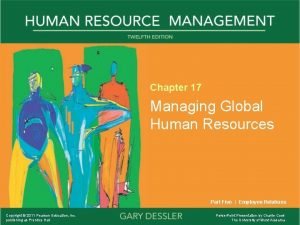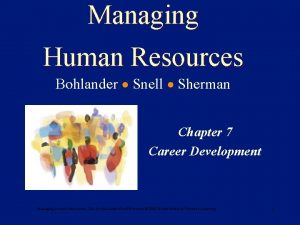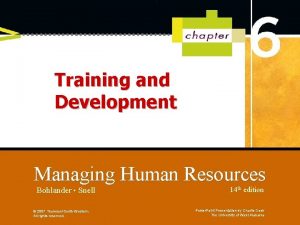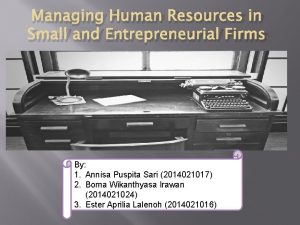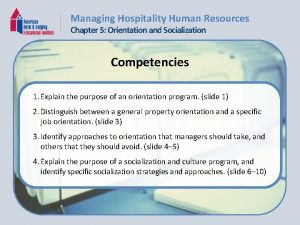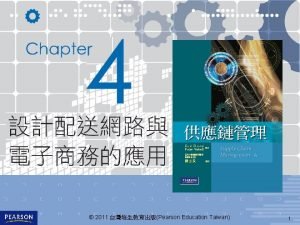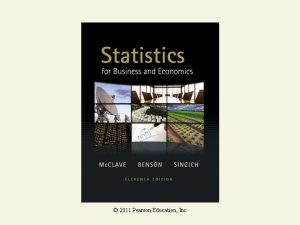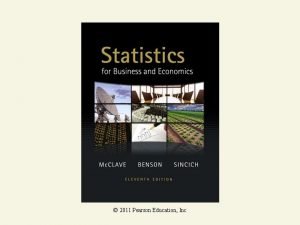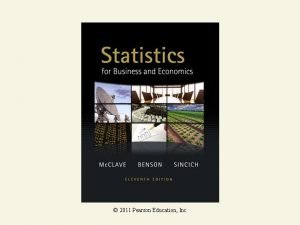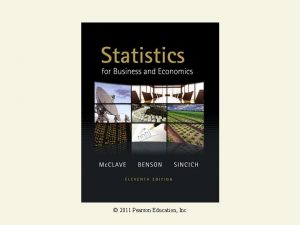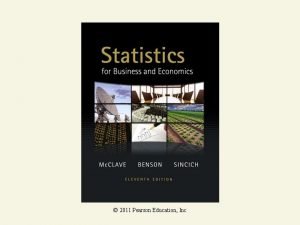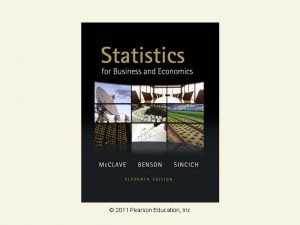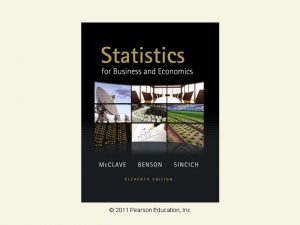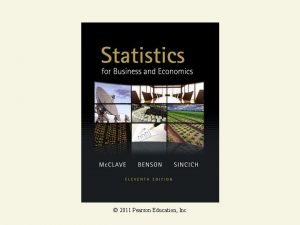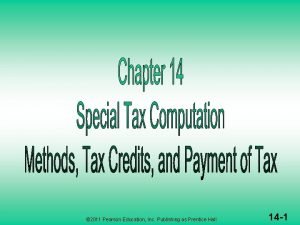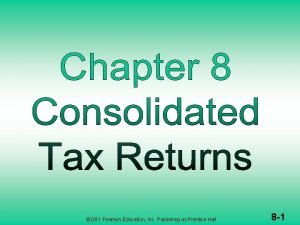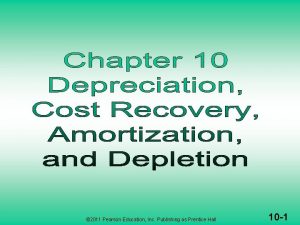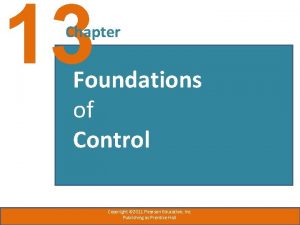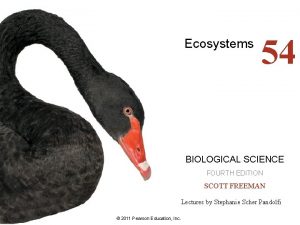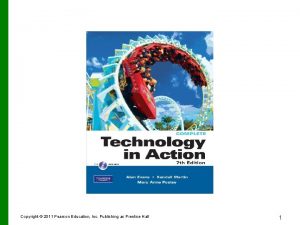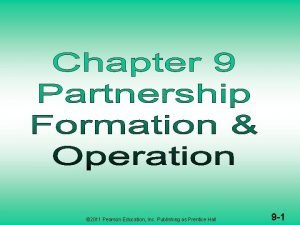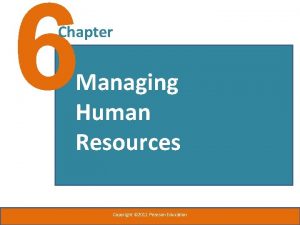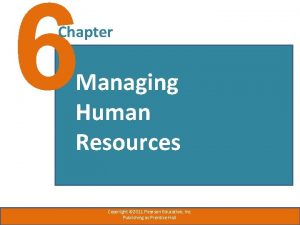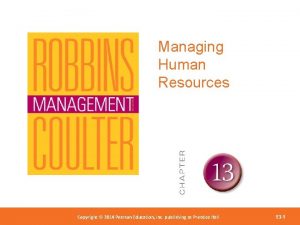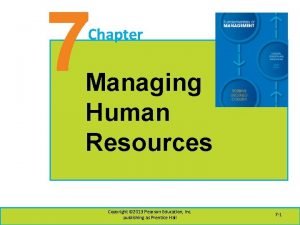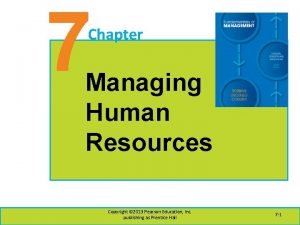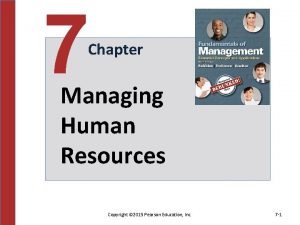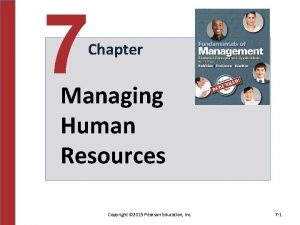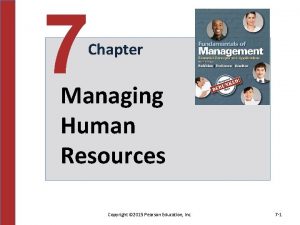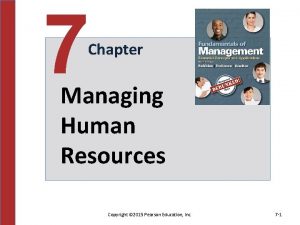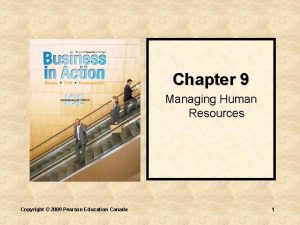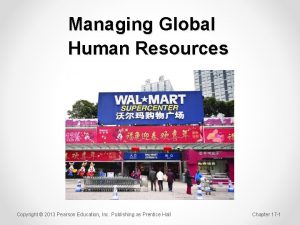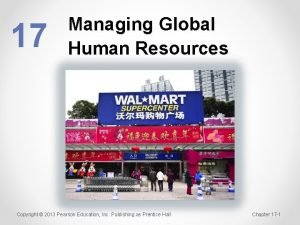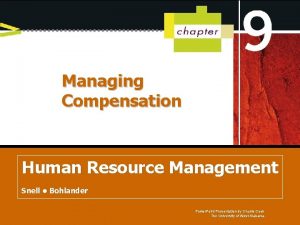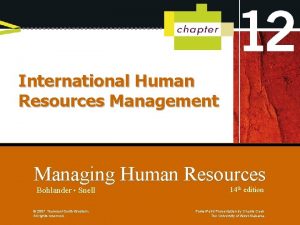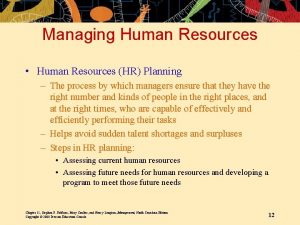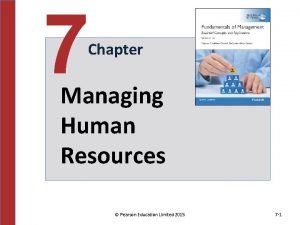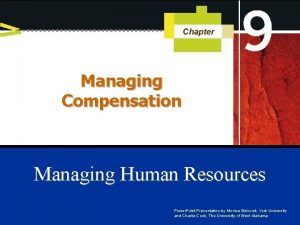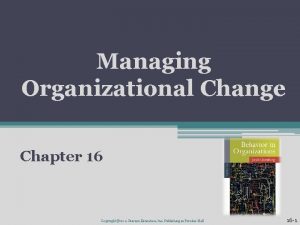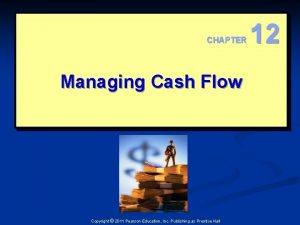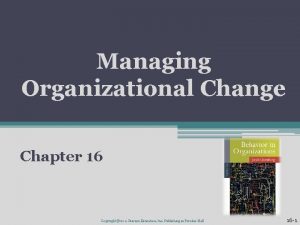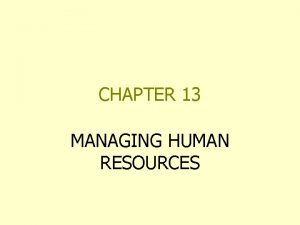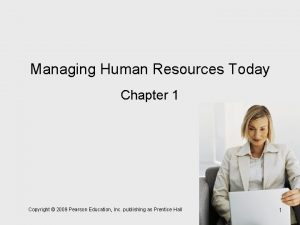6 Chapter Managing Human Resources Copyright 2011 Pearson




































- Slides: 36

6 Chapter Managing Human Resources Copyright © 2011 Pearson Education

Learning Objectives • Describe the key components of the HRM process and what influences it • Discuss the tasks associated with identifying and selecting competent employees • Explain how employees are provided with needed skills and knowledge • Describe strategies for retaining competent, highperforming employees • Discuss contemporary issues in managing human resources Copyright © 2011 Pearson Education 6 -2

What Is the Human Resource Management Process? • Human Resource Management (HRM) – The management function concerned with getting, training, motivating, and keeping competent employees Copyright © 2011 Pearson Education 6 -3

Copyright © 2011 Pearson Education 6 -4

What Is the Legal Environment of HRM? • Since the mid-1960 s, the federal government in the United States has greatly expanded its influence over HRM by enacting a number of laws and regulations including: • Affirmative Action Programs – Programs that ensure that decisions and practices enhance the employment, upgrading, and retention of members of protected groups Copyright © 2011 Pearson Education 6 -5

Copyright © 2011 Pearson Education 6 -6

Are HRM Laws the Same Globally? HRM laws aren’t the same globally. For example, German laws provide for worker representation in management decisions through • Work Councils – Groups of nominated or elected employees who must be consulted when management makes decisions involving personnel • Board Representatives – Employees who sit on a company’s board of directors and represent the interest of employees Copyright © 2011 Pearson Education 6 -7

What Is Employment Planning? • Employment Planning – The process by which managers ensure they have the right numbers and kinds of people in the right places at the right time – Employment planning translates the org’s mission and goals into HR plan that allow org to achieve those goals through : 1. Assessing both current and future human resource needs. 2. Developing a plan to meet those needs. Copyright © 2011 Pearson Education 6 -8

Conducting an employee assessment • Job Analysis – An assessment that defines jobs and the behaviors necessary to perform them • Job Description – A written statement that describes a job • Job Specification – A written statement of the minimum qualifications that a person must possess to perform a given job successfully Copyright © 2011 Pearson Education 6 -9

HOW DO ORGANIZATIONS RECRUIT EMPLOYEES? • Recruitment – Locating, identifying, and attracting capable applicants Copyright © 2011 Pearson Education 6 -10

Copyright © 2011 Pearson Education 6 -11

How do managers handle layoffs • Downsizing – The planned elimination of jobs in an organization • Layoff-Survivor Sickness – A set of attitudes, perceptions, and behaviors of employees who survive layoffs Copyright © 2011 Pearson Education 6 -12

Copyright © 2011 Pearson Education 6 -13

How Do Managers Select Job Applicants? • Selection Process – Screening job applicants to ensure that the most appropriate candidates are hired • Reliability – The degree to which a selection device measures the same characteristic consistently…. If a test is reliable , any individual score should be stable over time (assumin that the characteristic its measuring is also stable. Copyright © 2011 Pearson Education 6 -14

How Do Managers Select Job Applicants? • Validity – The proven relationship between a selection device and some relevant criterion…. for examples interviews, test and physical examination…. – disabled employee applying for a position in the fire dept. – It should be directly related to successful job performance – selection decision outcomes pg 187, 188 Copyright © 2011 Pearson Education 6 -15

Pre-Employment Testing One criticism of written tests is that they may measure characteristics which are not related to job performance. As a result, performancesimulation tests are gaining popularity • Performance-Simulation Tests – Selection devices based on actual job behaviors Copyright © 2011 Pearson Education 6 -16

Closing the Deal –hiring the employee Providing only details of positive aspects of a job may lead to satisfaction problems later. • Realistic Job Preview (RJP) – A preview of a job that provides both positive and negative information about the job and the company Copyright © 2011 Pearson Education 6 -17

How Are New Hires Introduced to the Organization? • Orientation – Introducing a new employee to the job and the organization • Employee Training – A learning experience that seeks a relatively permanent change in employees by improving their ability to perform on the job Copyright © 2011 Pearson Education 6 -18

Copyright © 2011 Pearson Education 6 -19

Copyright © 2011 Pearson Education 6 -20

How to evaluate employee performance ? • Performance Management System – A system that establishes performance standards and evaluating performance in order to arrive at objective human resource decision such as pay increase and training needs • 360 -degree appraisal – An appraisal device that seeks feedback from a variety of sources for the person being rated Copyright © 2011 Pearson Education 6 -21

Copyright © 2011 Pearson Education 6 -22

What Happens If an Employee’s Performance Is Not Up to Par? • Discipline – Actions taken by a manager to enforce an organization’s standards and regulations such as warning, suspension …etc • Employee Counseling – A process designed to help employees overcome performance-related problems…finding ways to fix the problem Copyright © 2011 Pearson Education 6 -23

How Are Employees Compensated? • Compensation Administration – The process of determining a cost-effective pay structure that will attract and retain employees, provide an incentive for them to work hard, and ensure that pay levels will be perceived as fair • Skill-based Pay – A pay system that rewards employees for the job skills they demonstrate Copyright © 2011 Pearson Education 6 -24

Compensation (cont. ) • Variable Pay – A pay system in which an individual’s compensation is contingent on performance • Employee Benefits – Nonfinancial rewards designed to enrich employees’ lives Copyright © 2011 Pearson Education 6 -25

Copyright © 2011 Pearson Education 6 -26

What Is Sexual Harassment? • Sexual Harassment – Any unwanted action or activity of a sexual nature that explicitly or implicitly affects an individual’s employment, performance, or work environment Copyright © 2011 Pearson Education 6 -27

What Is Workplace Spirituality? • Workplace Spirituality – A spiritual culture where organizational values promote a sense of purpose through meaningful work that takes place in the context of community Copyright © 2011 Pearson Education 6 -28

Copyright © 2011 Pearson Education 6 -29

Career Module Managing Your Career Copyright © 2011 Pearson Education 6 -30

Building Your Career • Career – The sequence of work positions held by a person during his or her lifetime • Boundaryless Career – When an individual takes personal responsibility for his or her own career Copyright © 2011 Pearson Education 6 -31

How Can I Have a Successful Career? • Assess Your Personal Strengths and Weaknesses – Where do your natural talents lie? • Identify Market Opportunities – Where are tomorrow’s job opportunities? • Take Responsibility for Managing Your Own Career • Develop Your Interpersonal Skills – Interpersonal skills, especially the ability to communicate, top the list of almost every employer’s “must have” skills Copyright © 2011 Pearson Education 6 -32

Career Success (cont. ) • Practice Makes Perfect – If you want to excel in any field, you should expect to have to put in a lot of deliberate practice • Stay Up-to-Date – To keep your career on track, you need to make learning a lifetime commitment • Network – Create and maintaining beneficial relationships with others in order to accomplish your goals Copyright © 2011 Pearson Education 6 -33

Career Success (cont. ) • Stay Visible – You increase your mobility and value in the marketplace by keeping visible • Seek a Mentor – Employees with mentors are likely to have enhanced mobility and increased knowledge of the organization • Leverage Your Competitive Advantage – Develop skills that will give you a competitive advantage in the marketplace Copyright © 2011 Pearson Education 6 -34

Career Success (cont. ) • Don’t Shun Risks • It’s OK to Change Jobs – To keep your skills fresh, your income increasing, and your job tasks interesting, it will be increasingly likely that you’ll need to change employers • Opportunities, Preparation, and Luck = Success Copyright © 2011 Pearson Education 6 -35

Copyright © 2011 Pearson Education 6 -36
 Chapter 10 managing human resources
Chapter 10 managing human resources Managing human resources in small and entrepreneurial firms
Managing human resources in small and entrepreneurial firms Employee selection
Employee selection Managing global human resources
Managing global human resources Managing human resources snell
Managing human resources snell Managing human resources bohlander
Managing human resources bohlander Managing human resources in small and entrepreneurial firms
Managing human resources in small and entrepreneurial firms Managing hospitality human resources
Managing hospitality human resources Managing global human resources
Managing global human resources Pearson education 2011
Pearson education 2011 2011 pearson education inc
2011 pearson education inc 2011 pearson education inc
2011 pearson education inc 2011 pearson education inc
2011 pearson education inc 2011 pearson education inc
2011 pearson education inc 2011 pearson education inc
2011 pearson education inc 2011 pearson education inc
2011 pearson education inc Prentice hall publishing
Prentice hall publishing 2011 pearson education inc
2011 pearson education inc 2011 pearson education inc
2011 pearson education inc 2011 pearson education inc
2011 pearson education inc 2011 pearson education inc
2011 pearson education inc Pearson education inc. publishing as prentice hall
Pearson education inc. publishing as prentice hall 2011 pearson education
2011 pearson education 2011 pearson education inc biology
2011 pearson education inc biology 2011 pearson education inc
2011 pearson education inc 2011 pearson education inc biology
2011 pearson education inc biology 2011 pearson education inc
2011 pearson education inc 2011 pearson education inc
2011 pearson education inc 2011 pearson education inc
2011 pearson education inc 2017 pearson education inc
2017 pearson education inc Copyright pearson education inc
Copyright pearson education inc Copyright 2010 pearson education inc
Copyright 2010 pearson education inc Copyright 2009
Copyright 2009 2018 pearson education inc
2018 pearson education inc 2014 pearson education inc
2014 pearson education inc Copyright 2010 pearson education inc
Copyright 2010 pearson education inc Copyright 2010 pearson education inc
Copyright 2010 pearson education inc
